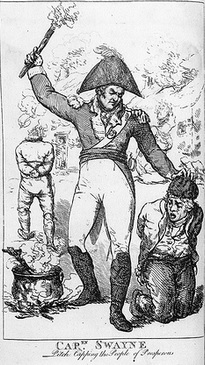Irish Rebellion of 1798
During the Irish Rebellion of 1798 against British rule in Ireland, government forces, in particular the militia and yeomanry, frequently used pitchcapping against suspected rebels.
United Irishman Myles Byrne described pitchcapping as follows: [1]
Flogging, half hanging, picketing, were mild tortures in comparison of the pitch caps that were applied to the heads of those who happened to wear their hair short, called croppies; the head being completely singed, a cap made of strong linen well imbued with boiling pitch was so closely put on that it could not be taken off without bringing off a part of the skin and flesh from the head: in many instances the tortured victim had one of his ears cut off to satisfy the executioner that if he escaped he could readily be discovered, being so well marked.
Another description of the torture involves pitch being "rubbed on the victim’s head, gunpowder added and the mixture set fire to." [2] A prominent victim of pitchcapping as a form of interrogational torture was Anthony Perry, a leader of the Wexford Rebellion.
There are also accounts of the rebels themselves carrying out the torture method. The Protestant Irishwoman Jane Adams describes finding her brother with "his beard an inch long; his hair cut close to his head, one side of which was bleeding, where the rebels had put a pitch plaster, which he had torn off." [4]
This page is based on this
Wikipedia article Text is available under the
CC BY-SA 4.0 license; additional terms may apply.
Images, videos and audio are available under their respective licenses.
